Abstract
The serum high density lipoprotein (HDL) subfractions, HDL2, and HDL3, and serum apolipoprotein AI and B (apo AI and B) were evaluated as potential indicators of the risk of ischaemic heart disease in men aged less than 60 years who had previously had a myocardial infarction and in controls with a similar socioeconomic background who had no history of myocardial ischaemia. Discriminant analysis confirmed that the combination of serum cholesterol, triglycerides, and total HDL cholesterol distinguished poorly between patients and controls. The best single discriminating variable was apo B. Stepwise discriminant analysis showed that this discrimination could be improved to a small extent by combining apo B with apo AI and parental history, but nothing was gained by measurement of serum cholesterol triglycerides, very low density lipoprotein cholesterol, low density lipoprotein cholesterol, HDL cholesterol, HDL2 or HDL3 cholesterol. Significantly more patients than controls with type IV hyperlipoproteinaemia had raised concentrations of serum apolipoprotein B, but the frequency of raised apolipoprotein B concentrations was no greater in patients with type IV hyperlipoproteinaemia than in those with normal serum lipids. The value of apo B as an indicator of cardiovascular risk should be assessed in prospective studies.
Full text
PDF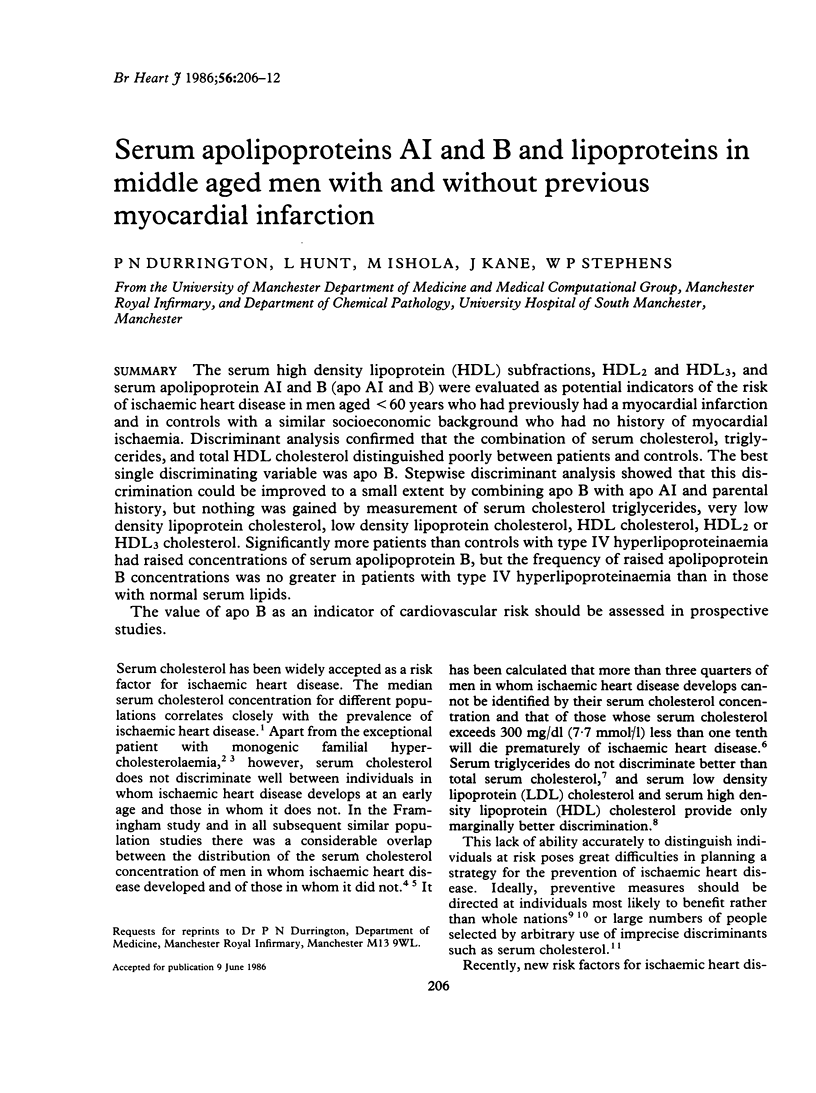
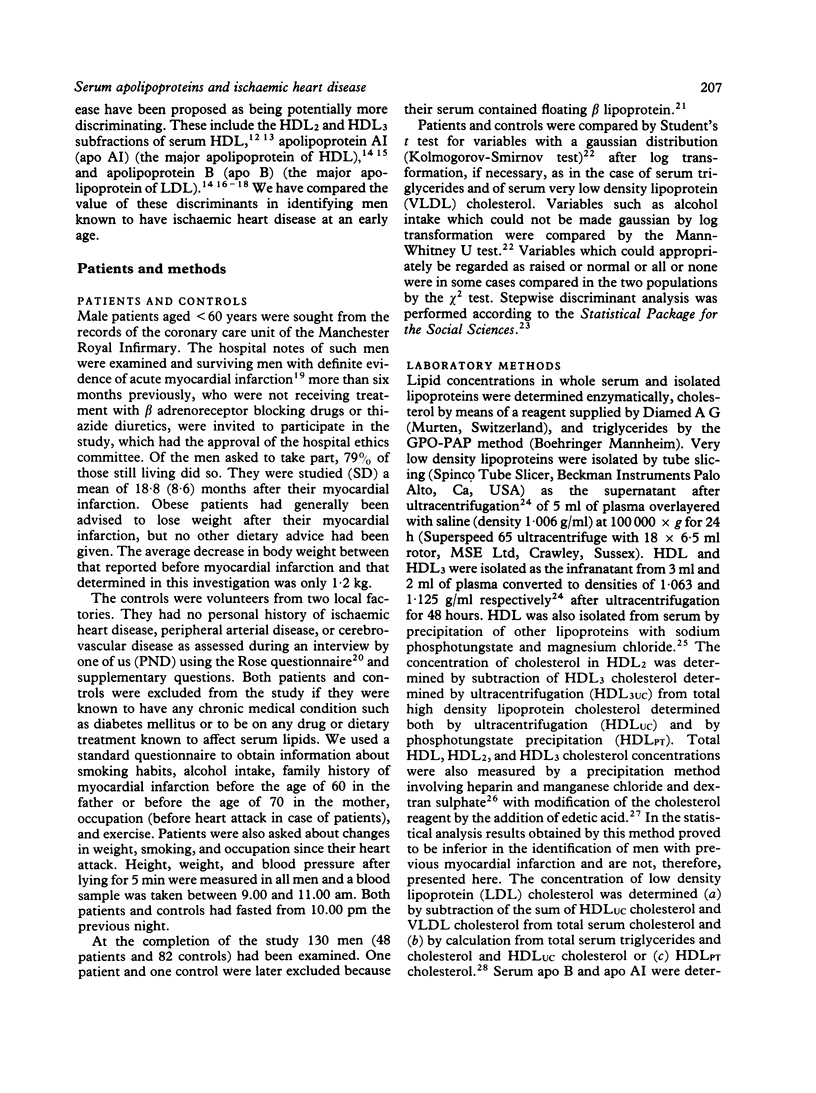
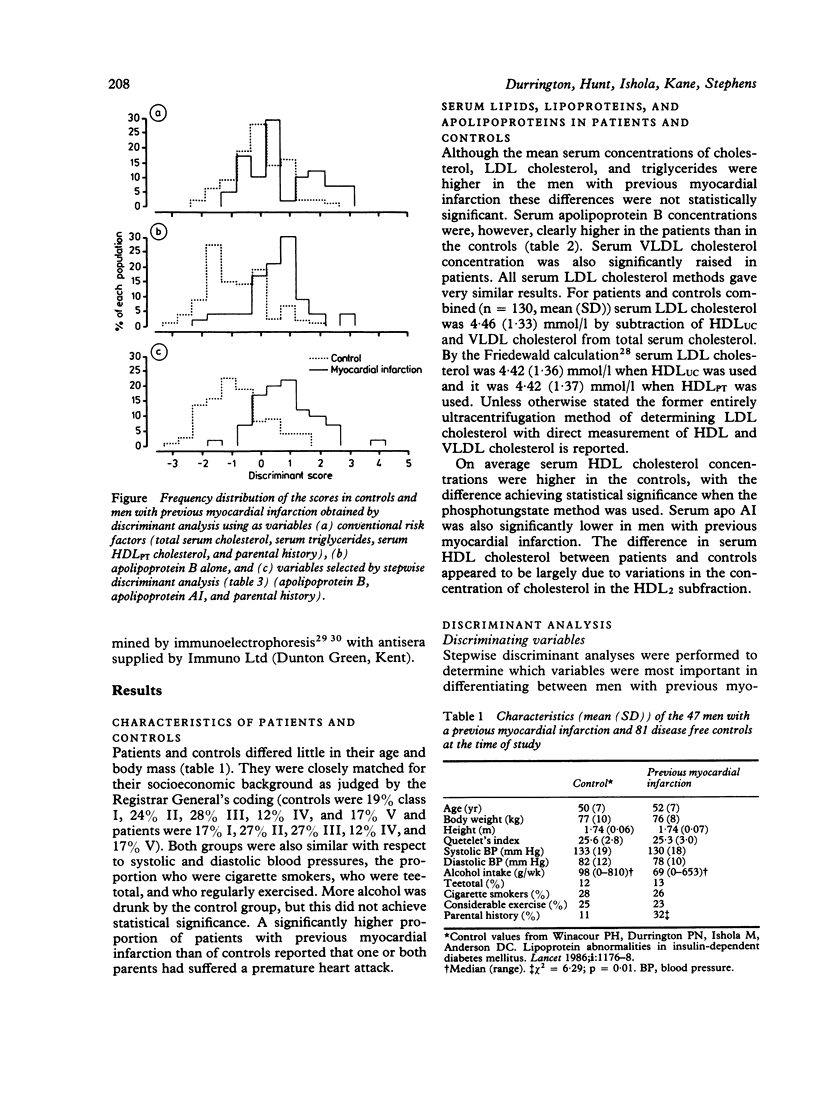
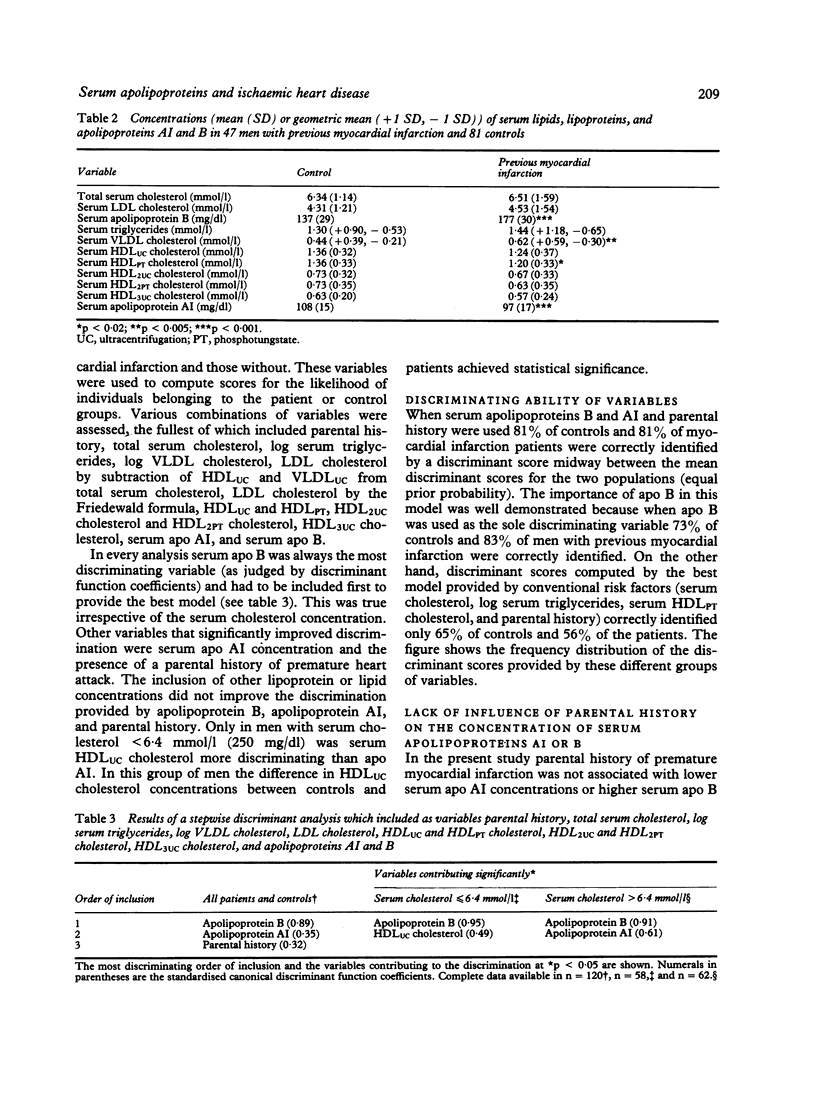
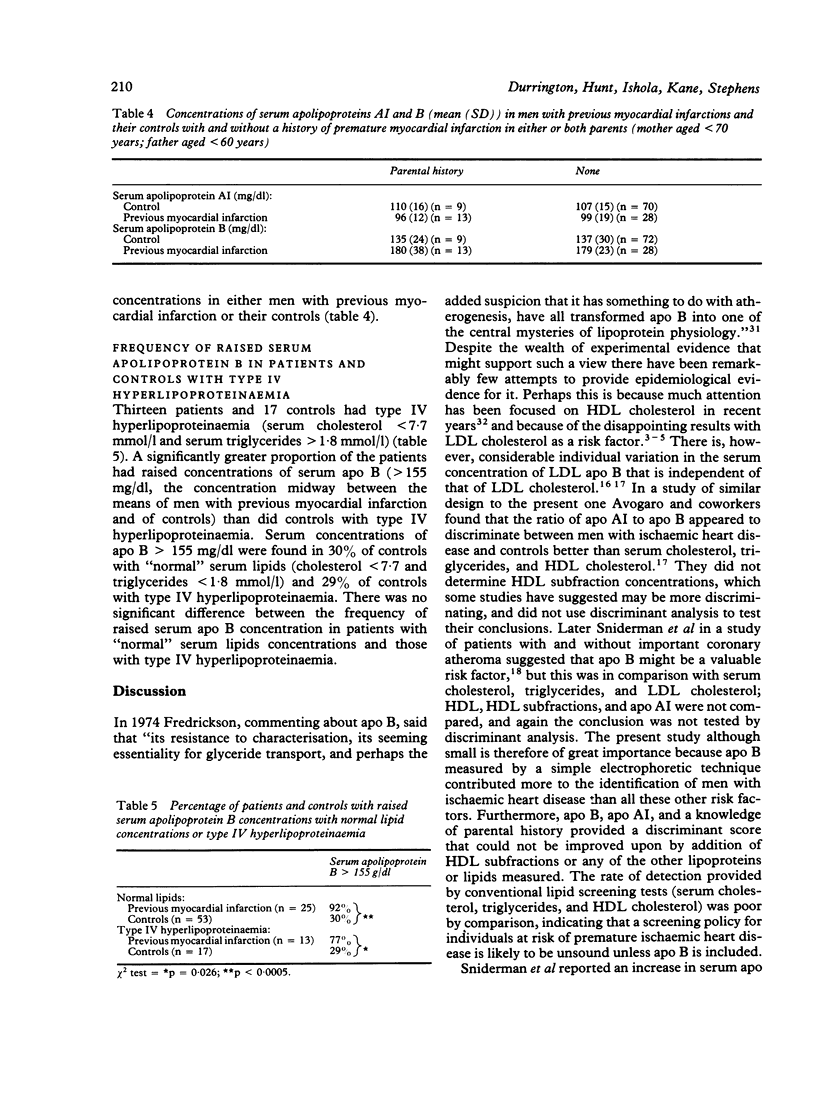
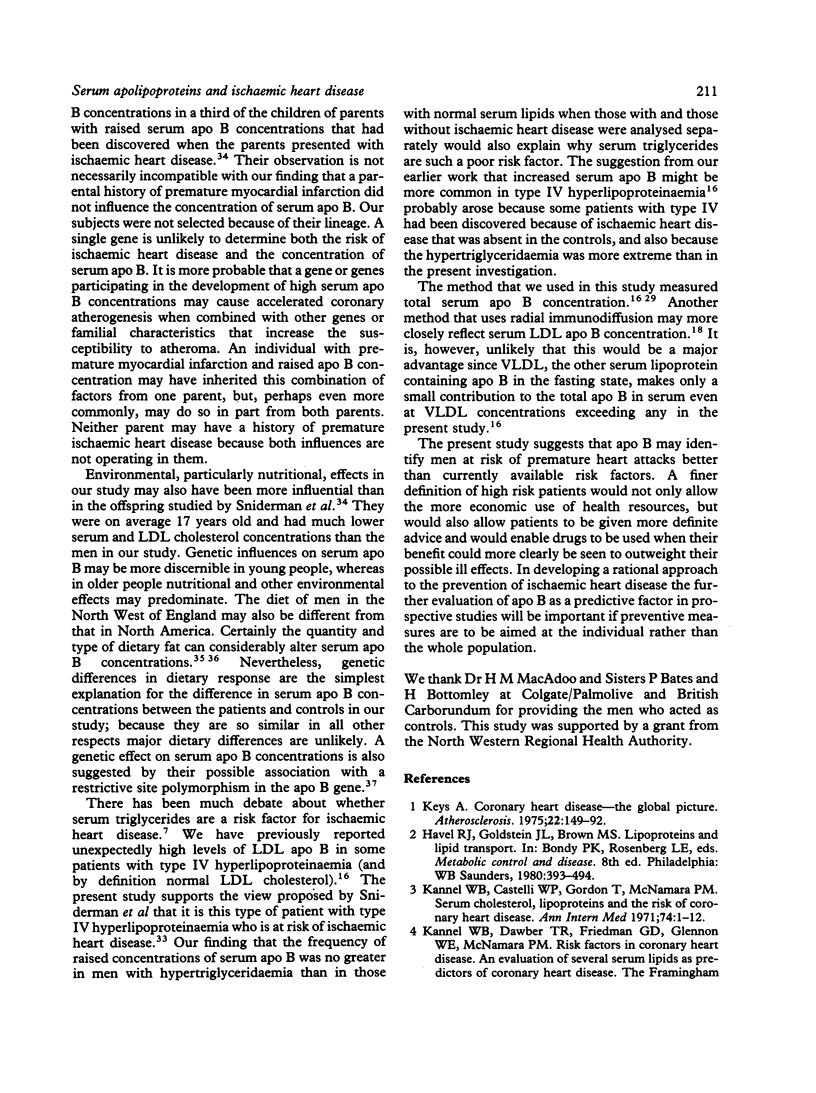
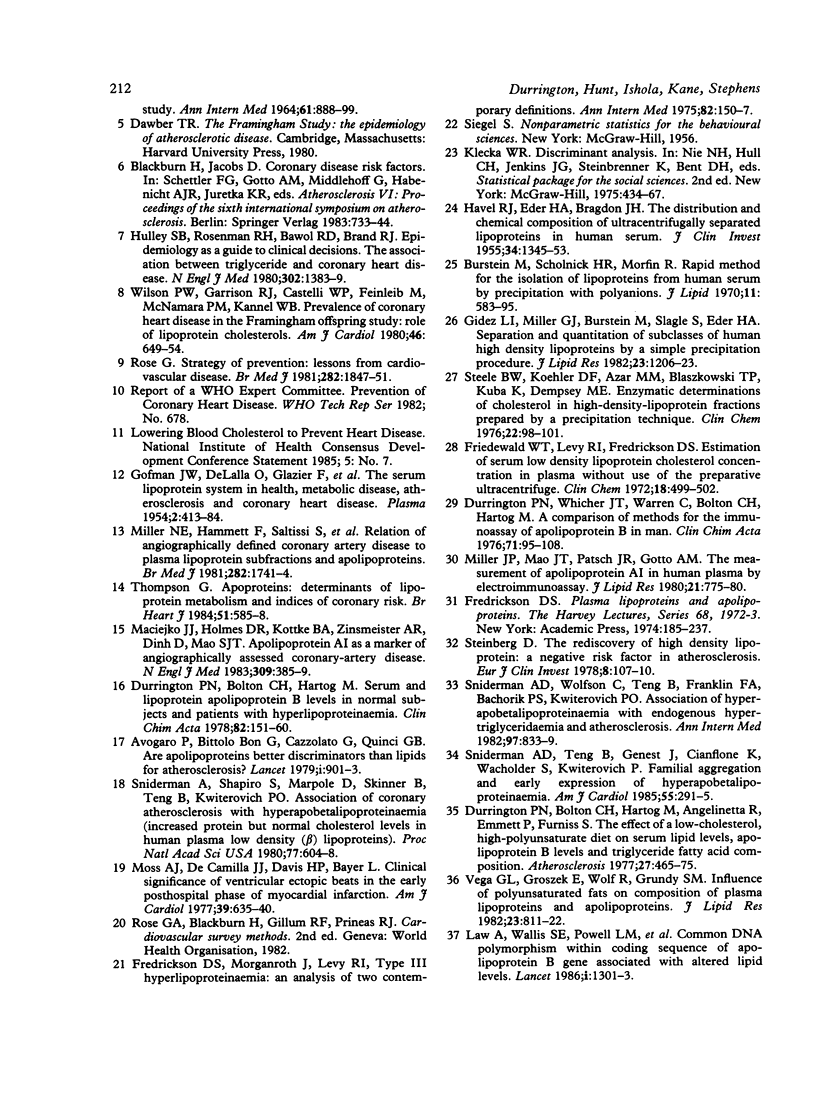
Selected References
These references are in PubMed. This may not be the complete list of references from this article.
- Avogaro P., Bon G. B., Cazzolato G., Quinci G. B. Are apolipoproteins better discriminators than lipids for atherosclerosis? Lancet. 1979 Apr 28;1(8122):901–903. doi: 10.1016/s0140-6736(79)91375-8. [DOI] [PubMed] [Google Scholar]
- Burstein M., Scholnick H. R., Morfin R. Rapid method for the isolation of lipoproteins from human serum by precipitation with polyanions. J Lipid Res. 1970 Nov;11(6):583–595. [PubMed] [Google Scholar]
- Durrington P. N., Bolton C. H., Hartog M., Angelinetta R., Emmett P., Furniss S. The effect of a low-cholesterol, high-polyunsaturate diet on serum lipid levels, apolipoprotein B levels and triglyceride fatty acid composition. Atherosclerosis. 1977 Aug;27(4):465–475. doi: 10.1016/0021-9150(77)90164-2. [DOI] [PubMed] [Google Scholar]
- Durrington P. N., Bolton C. H., Hartog M. Serum and lipoprotein apolipoprotein B levels in normal subjects and patients with hyperlipoproteinaemia. Clin Chim Acta. 1978 Jan 2;82(1-2):151–160. doi: 10.1016/0009-8981(78)90038-4. [DOI] [PubMed] [Google Scholar]
- Durrington P. N., Whicher J. T., Warren C., Bolton C. H., Hartog M. A comparison of methods for the immunoassay of serum apolipoprotein B in man. Clin Chim Acta. 1976 Aug 16;71(1):95–108. doi: 10.1016/0009-8981(76)90280-1. [DOI] [PubMed] [Google Scholar]
- Fredrickson D. S., Morganroth J., Levy R. I. Type III hyperlipoproteinemia: an analysis of two contemporary definitions. Ann Intern Med. 1975 Feb;82(2):150–157. doi: 10.7326/0003-4819-82-2-150. [DOI] [PubMed] [Google Scholar]
- Fredrickson D. S. Plasma lipoproteins and apolipoproteins. Harvey Lect. 1974;68:185–237. [PubMed] [Google Scholar]
- Friedewald W. T., Levy R. I., Fredrickson D. S. Estimation of the concentration of low-density lipoprotein cholesterol in plasma, without use of the preparative ultracentrifuge. Clin Chem. 1972 Jun;18(6):499–502. [PubMed] [Google Scholar]
- Gidez L. I., Miller G. J., Burstein M., Slagle S., Eder H. A. Separation and quantitation of subclasses of human plasma high density lipoproteins by a simple precipitation procedure. J Lipid Res. 1982 Nov;23(8):1206–1223. [PubMed] [Google Scholar]
- HAVEL R. J., EDER H. A., BRAGDON J. H. The distribution and chemical composition of ultracentrifugally separated lipoproteins in human serum. J Clin Invest. 1955 Sep;34(9):1345–1353. doi: 10.1172/JCI103182. [DOI] [PMC free article] [PubMed] [Google Scholar]
- Hulley S. B., Rosenman R. H., Bawol R. D., Brand R. J. Epidemiology as a guide to clinical decisions. The association between triglyceride and coronary heart disease. N Engl J Med. 1980 Jun 19;302(25):1383–1389. doi: 10.1056/NEJM198006193022503. [DOI] [PubMed] [Google Scholar]
- KANNEL W. B., DAWBER T. R., FRIEDMAN G. D., GLENNON W. E., MCNAMARA P. M. RISK FACTORS IN CORONARY HEART DISEASE. AN EVALUATION OF SEVERAL SERUM LIPIDS AS PREDICTORS OF CORONARY HEART DISEASE; THE FRAMINGHAM STUDY. Ann Intern Med. 1964 Nov;61:888–899. doi: 10.7326/0003-4819-61-5-888. [DOI] [PubMed] [Google Scholar]
- Kannel W. B., Castelli W. P., Gordon T., McNamara P. M. Serum cholesterol, lipoproteins, and the risk of coronary heart disease. The Framingham study. Ann Intern Med. 1971 Jan;74(1):1–12. doi: 10.7326/0003-4819-74-1-1. [DOI] [PubMed] [Google Scholar]
- Keys A. Coronary heart disease--the global picture. Atherosclerosis. 1975 Sep-Oct;22(2):149–192. doi: 10.1016/0021-9150(75)90001-5. [DOI] [PubMed] [Google Scholar]
- Law A., Wallis S. C., Powell L. M., Pease R. J., Brunt H., Priestley L. M., Knott T. J., Scott J., Altman D. G., Miller G. J. Common DNA polymorphism within coding sequence of apolipoprotein B gene associated with altered lipid levels. Lancet. 1986 Jun 7;1(8493):1301–1303. doi: 10.1016/s0140-6736(86)91222-5. [DOI] [PubMed] [Google Scholar]
- Maciejko J. J., Holmes D. R., Kottke B. A., Zinsmeister A. R., Dinh D. M., Mao S. J. Apolipoprotein A-I as a marker of angiographically assessed coronary-artery disease. N Engl J Med. 1983 Aug 18;309(7):385–389. doi: 10.1056/NEJM198308183090701. [DOI] [PubMed] [Google Scholar]
- Miller J. P., Mao S. J., Patsch J. R., Gotto A. M., Jr The measurement of apolipoprotein A-I in human plasma by electroimmunoassay. J Lipid Res. 1980 Aug;21(6):775–780. [PubMed] [Google Scholar]
- Miller N. E., Hammett F., Saltissi S., Rao S., van Zeller H., Coltart J., Lewis B. Relation of angiographically defined coronary artery disease to plasma lipoprotein subfractions and apolipoproteins. Br Med J (Clin Res Ed) 1981 May 30;282(6278):1741–1744. doi: 10.1136/bmj.282.6278.1741. [DOI] [PMC free article] [PubMed] [Google Scholar]
- Moss A. J., DeCamilla J. J., Davis H. P., Bayer L. Clinical significance of ventricular ectopic beats in the early posthospital phase of myocardial infarction. Am J Cardiol. 1977 May 4;39(5):635–640. doi: 10.1016/s0002-9149(77)80122-7. [DOI] [PubMed] [Google Scholar]
- Rose G. Strategy of prevention: lessons from cardiovascular disease. Br Med J (Clin Res Ed) 1981 Jun 6;282(6279):1847–1851. doi: 10.1136/bmj.282.6279.1847. [DOI] [PMC free article] [PubMed] [Google Scholar]
- Sniderman A. D., Wolfson C., Teng B., Franklin F. A., Bachorik P. S., Kwiterovich P. O., Jr Association of hyperapobetalipoproteinemia with endogenous hypertriglyceridemia and atherosclerosis. Ann Intern Med. 1982 Dec;97(6):833–839. doi: 10.7326/0003-4819-97-6-833. [DOI] [PubMed] [Google Scholar]
- Sniderman A., Shapiro S., Marpole D., Skinner B., Teng B., Kwiterovich P. O., Jr Association of coronary atherosclerosis with hyperapobetalipoproteinemia [increased protein but normal cholesterol levels in human plasma low density (beta) lipoproteins]. Proc Natl Acad Sci U S A. 1980 Jan;77(1):604–608. doi: 10.1073/pnas.77.1.604. [DOI] [PMC free article] [PubMed] [Google Scholar]
- Sniderman A., Teng B., Genest J., Cianflone K., Wacholder S., Kwiterovich P., Jr Familial aggregation and early expression of hyperapobetalipoproteinemia. Am J Cardiol. 1985 Feb 1;55(4):291–295. doi: 10.1016/0002-9149(85)90363-7. [DOI] [PubMed] [Google Scholar]
- Steele B. W., Koehler D. F., Azar M. M., Blaszkowski T. P., Kuba K., Dempsey M. E. Enzymatic determinations of cholesterol in high-density-lipoprotein fractions prepared by a precipitation technique. Clin Chem. 1976 Jan;22(1):98–101. [PubMed] [Google Scholar]
- Steinberg D. The rediscovery of high density lipoprotein: a negative risk factor in atherosclerosis. Eur J Clin Invest. 1978 Jun;8(3):107–109. doi: 10.1111/j.1365-2362.1978.tb00821.x. [DOI] [PubMed] [Google Scholar]
- Thompson G. Apoproteins: determinants of lipoprotein metabolism and indices of coronary risk. Br Heart J. 1984 Jun;51(6):585–588. doi: 10.1136/hrt.51.6.585. [DOI] [PMC free article] [PubMed] [Google Scholar]
- Vega G. L., Groszek E., Wolf R., Grundy S. M. Influence of polyunsaturated fats on composition of plasma lipoproteins and apolipoproteins. J Lipid Res. 1982 Aug;23(6):811–822. [PubMed] [Google Scholar]
- Wilson P. W., Garrison R. J., Castelli W. P., Feinleib M., McNamara P. M., Kannel W. B. Prevalence of coronary heart disease in the Framingham Offspring Study: role of lipoprotein cholesterols. Am J Cardiol. 1980 Oct;46(4):649–654. doi: 10.1016/0002-9149(80)90516-0. [DOI] [PubMed] [Google Scholar]


